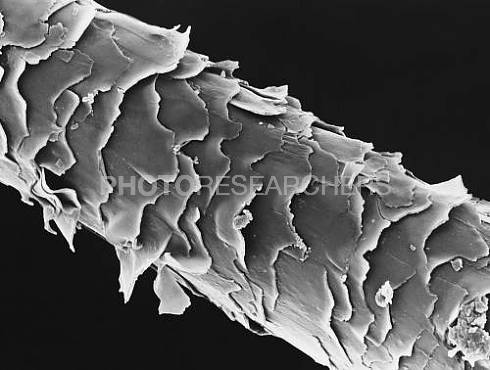I have heard several people complain that there are way too many rules for gaining and maintaining healthy hair. Don’t use ‘cones, don’t use heat, don’t use sulfate shampoos, don’t comb your hair without conditioner in it, don’t touch your hair and dance to a song (you caught me, I just threw that in there. Just checking to see that you are paying attention :)).
I have found that some of those rules are well meaning guidelines to healthy hair and that they are not unfounded. A lot of them are based on scientific research as well as tried and tested method. As with everything – we have free will and will ultimately decide what path we wish to follow.
In this post I wanted to share a few pictures of strands of hair up close. Perhaps they will help us decide if we need to re-evaluate our methods of hair care.
Let’s dive in shall we?
Here we see a healthy strand of hair. How can we tell it is healthy? The cuticles (those pattern like things you see) are all lying flat. There is no tearing or exposure of anything that is underneath the cuticle and the hair doesn’t look distressed in any way.
Let’s compare it with this picture of an unhealthy hair strand.
This is an even more damaged strand of hair. The fact that the cuticle is raised means that things can get into the hair shaft or out. That is called…porosity (there are two types).
Damaged hair shaft. Here the cuticle is completely torn off and the bits it is supposed to be protecting underneath (cortex et al) are exposed. There is no way to redeem this hair strand.
You know how they say detangle, detangle? Stretch your hair and stretch your hair some more? That is so that we can avoid knots like these.
Single Strand Knot. Imagine trying to undo that on your hair. Actually several of them as they pop up all over the place on tangled (and even stretched hair). You have better chances of not getting them when your hair is stretched.
Another view of split ends
Split ends on a strand of hair. You can see how easy it will be for that to go all the way down to the roots.
And as a bonus, I am throwing in this one.
Head louse on a strand of hair. See how tenaciously it is holding on? A pain to get rid of. It isn’t naturally green by the way, the picture has been enhanced using false color scanning.
So what caused the majority of these damaged hair strands? Rather than use my own words, I will lift right off the Science Photo Web page:
“Damaged human hair shaft…. This can be caused by overheating the hair using curling tongs or hair straigheners, as well as chemical dyes, back combing and over brushing. Hair straighteners can get so hot that the moisture inside the hair shaft can reach boiling temperatures, leaving the hair seriously damaged. The cuticle or scales which cover the outside of each hair shaft can be stripped off. The hair will become brittle, dry and frizzy causing breakages along the shaft.”
Makes you wonder about the wisdom of brushing some of these hair rules aside (forgive the pun). Now that the over 100,000 strands of your hair were affected in some way or form like the damaged hair strands we’ve seen here….
Next post, I will be talking about some guidelines (I don’t like the word “rules”) for healthy hair.








